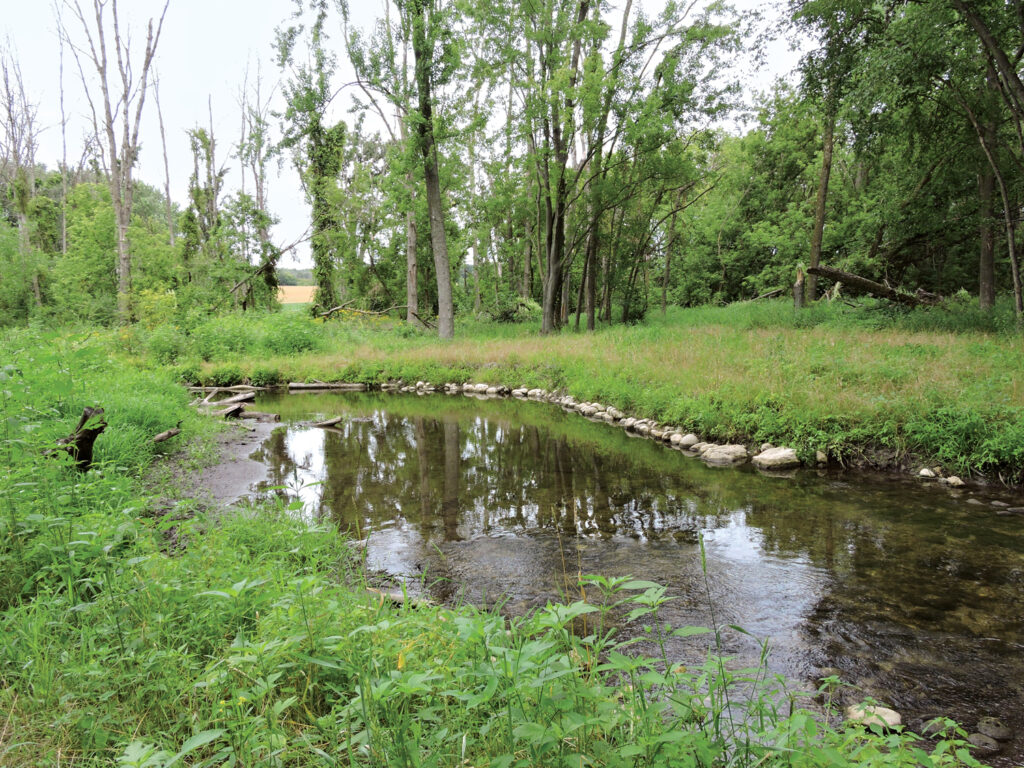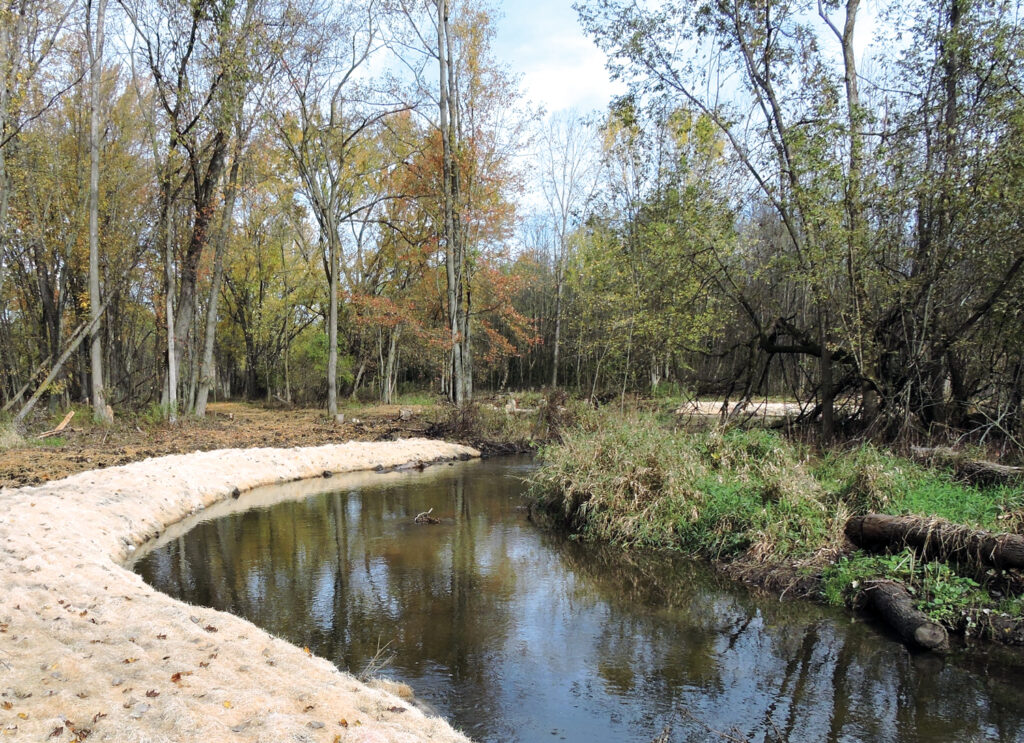
There’s something about cold, bubbling trout water that can relax almost anyone (Figure 2). Thus, it is imperative to conserve and restore our precious streams and rivers for future generations to experience and enjoy. With this in mind, the Lakeshore Chapter of Wisconsin Trout Unlimited (LSTU) undertook a project starting in 2019 to repair and enhance existing river restoration improvements and expand improved water into a new section of the Onion River outside of Plymouth, which is located in East Central Wisconsin. The environmentally sensitive site is in a floodplain and wetland forest surrounding a trout stream on State of Wisconsin Department of Natural Resources (WIDNR) managed lands.

Project scope
The first stage of the project was designed by WIDNR to include brushing out and stabilizing the banks of the river with brush bundles, bio-logs, tree drops, and bank covering. Upon completion of this work, LSTU would then undertake the installation of fixed structures within the stream itself. These structures were to include bank covers, half logs, and log drops. These efforts were identified to provide habitat for multiple year classes of trout. LSTU would consult with the WIDNR during all stages of the project.
Unforeseen challenges
No project of this magnitude goes perfectly without challenges to overcome. Significant challenges arose throughout the process that impaired the team’s ability to complete the entire scope, including the impact of the worldwide COVID-19 pandemic, which caused the project team to cancel several workdays throughout 2020 and 2021, even though the work was outdoors.
Furthermore, a local WIDNR biologist, who played a significant role in designing the original project for LSTU departed, which caused the team to seek out help from other regional and state staff. New members to the project team asked for changes to the original plans, which caused delays in commencement. In addition, the area contained a lot of ash trees, which were unfortunately killed by the emerald ash borer. Some of the dead trees had to be removed (Figure 3) before they would potentially fall into the river and create damming effects that would be counter-productive to the project’s goals. Lastly, delays from equipment and machinery breakdowns also had to be overcome during the project.

Executing the plan
While the team was initially negatively impacted by the change in staff, they were fortunate to secure additional help from the WIDNR Trout Habitat team. The WIDNR team allowed the group to complete part of the planned work in the fall of 2021, which included removal of trees that were growing streamside and destabilizing the bank. The completed work also included repairing several hundred feet of stream bank that included brush bundles, bank reduction, and 36 half-log structures on the stream bottom to provide cover and bio-log placement. The team also installed two bank covers over 60 feet (18.3 m) each that provided 120 feet (36.6 m) of habitat improvement for multiple year classes of fish within the lunker structures below.

Boulders were placed into the stream to assist with current flow. Repair of existing lunker structures from the late 1990s and 2000s was also completed. Construction of the new lunker structures (Figures 4, 5, and 6) started with the banks being properly shaped with equipment. Next, the newly shaped banks were wrapped in an open weave coir material. Repurposed posts, which were made from black locust trees, were donated from a local YMCA camp. They were pounded into the stream bottom until firm, to form the main anchoring support for the lunker structure. Boards of lumber were then fixed to the posts to build the structure itself. Rip rap was placed along the top face of the finished structure, then the final backfilled soil was seeded and covered to complete the bank covers.

Curlex® NetFree™ erosion control blanket (ECB), manufactured by American Excelsior Company from Great Lakes aspen, was chosen for protecting the environmentally sensitive banks of the trout stream after the improvements were made (Figure 7).
This completely biodegradable ECB is naturally seed-free, so there was no concern about possibly introducing foreign seeds onto the project like what can happen when using erosion products containing agricultural-based materials. The unique ECB does not contain chemical components such as toxic malachite green or other binders, thus there were no concerns of potential chemical runoff into the sensitive adjacent trout waters. In addition, ECBs are held together with physical bonds that also provide high performance capabilities. The project team could not risk material and chemicals washing into the river, and they needed a cover material that would last long enough for native seeds, so the netless, biodegradable ECB was a natural fit.

The chemical free aspen excelsior covering (Figures 8, 9, and 10) is designed to hold the seed bed in place until vegetation becomes established. This project applied a native seed mix designed specifically for detention basins at a rate of 10 lb/ac (11.2 kg/ha), with an added cover crop. Overall, the native seed mix contained 46.4% wildflowers and 53.6% grasses, sedges, and rushes. The cover crop used was a sterile hybrid wheatgrass (Triticum aestivum x Elymus trachycaulus) that does not set viable seed in the absence of outside wheat pollen. Curlex NetFree was secured to the soil using biodegradable E-Staple®, by American Excelsior Company.

Results
The project team was able to take on a significant amount of work, with the help of WIDNR, that allowed them to complete over 900 feet (274.3 m) of restoration work on the Onion River in Sheboygan County, Wis. (Figure 11). Additional work included the repairs of several existing lunker structures in the project area. Lastly, the team repaired large sections of bank all along the river (Figure 12). The completed work will have lasting impacts, which will provide improved fish habitat and angling opportunities for the public. Visual observations documented immediate changes to local populations of trout who took residence in the new section of repaired stream. The crib-like wooden lunker structures installed along the toe of the river now provide trout, and other fish, habitat in the form of overhead cover. They also provide stalking and resting areas for various size classes within the under-bank structure. Lunker structures date back to 1982 when WIDNR first introduced them as an alternative to habitat improvement for trout waterways. The years of planning and hard work by the team are thankfully showing positive returns already (Figure 1). The improvements and structures all seem to be holding up as designed, and the site has revegetated nicely.



Al Wortz, LSTU president, stated, “The project went well overall after overcoming a few curve balls. We significantly improved cold-water habitat for trout and many other species. We were pleased with most of the materials we used, such as the Curlex NetFree product. It was easy to install, is safe for all wildlife and organisms, and it performed at a high level holding the seed and soil in place even during severe events. Overall, the project was a great group effort, and we look forward to accomplishing more in the future.”

Next steps
The team completed a significant amount in the time they had to work and with the hurdles that had to be overcome. However, more work is needed, so the team is looking forward to working closely with the new local biologist for the area. LSTU will work directly with WIDNR to help secure new permitting and guidance.
LSTU has already secured all material related to potential forthcoming structure repairs and intends to continue working on the Onion River in conjunction with their local WIDNR office. The future of the bubbling trout waters is bright thanks to all involved with this awesome project.

LSTU has received the following awards since this project wrapped up: 2022 Sheboygan County Conservation Association (SCCA) Water Conservationists of the Year; 2022 Wisconsin Wildlife Federation: Land Conservationists of the Year; 2022 Wisconsin Conservation Congress: State Conservation Organization of the Year.
A special thanks goes out to the entire Lakeshore Trout Unlimited Chapter for all their work on this project and other projects that will help ensure future generations have the thrill of bubbling trout water.
Kurt Kelsey is the division director at American Excelsior Company—Earth Science Division in Arlington, Texas. He has a bachelor of science degree in water resources with an emphasis in watershed science and a minor in soil science from the University of Wisconsin-Stevens Point and a masters of science in natural resources with an emphasis in soil and water science from the University of Wisconsin—Stevens Point. He is also the president of the Erosion Control Technology Council (ECTC).
Figures are courtesy of LSTU except where noted.
Project Highlights
River Restoration Practices for Improved Trout Water Quality
Owner: Wisconsin Department of Natural Resources (WIDNR)
Location: Plymouth, Wis.
Contractor: Lakeshore Chapter of Trout Unlimited (LSTU)/WIDNR
Construction company: LSTU/WIDNR
Engineers: Wisconsin DNR
Erosion control product: Curlex® NetFree™
Erosion control product manufacturer: American Excelsior Company®
 TEXTILES.ORG
TEXTILES.ORG


